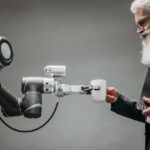Artificial Intelligence (AI) is like a symphony—it takes a group of talented players, each with their own instrument, to make the magic happen. Whether it’s a chatbot helping customers or a system predicting weather patterns, an AI team is a mix of unique roles working together. If you’re curious about who does what in an AI project, let’s meet the key players!
Data Engineer: The Data Plumber
Think of data as the fuel for AI. Data engineers are the ones who build the pipelines to keep it flowing. They collect, clean, and organize massive amounts of raw data so the team can use it. Imagine a retail company wanting an AI to recommend products. The data engineer pulls sales records, customer clicks, and inventory stats from databases, fixes messy entries (like “shooes” instead of “shoes”), and sets up a system to keep it all updated. Without them, the team’s stuck with a tank of dirty fuel.
Data Scientist: The Pattern Detective
Data scientists take that clean data and turn it into insights. They’re the ones digging through numbers to find trends and building models to predict what’s next. For example, Netflix uses data scientists to figure out what shows you’ll binge-watch based on your viewing history. They use math, stats, and coding to train AI models—like teaching a dog new tricks, but with algorithms instead of treats. They’re curious problem-solvers who love asking, “What if?”
ML Ops Engineer: The Model Mechanic
Machine Learning Operations (ML Ops) engineers keep the AI running smoothly once it’s built. They’re like car mechanics for models, making sure they don’t break down in the real world. Say a bank deploys an AI to detect fraudulent transactions. The ML Ops engineer monitors it, updates it with new data (like emerging scam tactics), and fixes glitches. They bridge the gap between the lab and live action, ensuring the AI doesn’t just sit on a shelf collecting dust.
Data Analyst: The Storyteller
While data scientists build models, data analysts focus on explaining what the data says. They create charts, dashboards, and reports that anyone can understand. Picture a hospital using AI to predict patient wait times. The data analyst crunches the numbers and shows the staff a simple graph: “Wait times spike at 3 p.m. on Mondays.” They don’t build the AI, but they make its insights actionable for decision-makers.
Research Scientist: The Innovator
Research scientists are the brainy explorers pushing AI’s boundaries. They dive into cutting-edge ideas, like inventing new algorithms or improving how AI “thinks.” Think of Google’s DeepMind team, who created AlphaGo to beat world champions at the game Go. These folks often have PhDs and love tackling big, unsolved problems. They’re less about today’s project and more about tomorrow’s breakthroughs.
Software Engineer: The Builder
Software engineers turn AI ideas into working products. They write the code that connects the model to an app or website. For instance, when you ask Siri a question, software engineers make sure the AI’s answer pops up on your phone. They’re the construction crew, building the house around the AI’s brain so it’s useful and user-friendly.
Product Manager: The Vision Keeper
Every team needs a leader to steer the ship, and that’s the product manager. They decide what the AI should do and why it matters. Take Spotify’s “Discover Weekly” playlist— a product manager likely said, “Let’s use AI to give users new songs they’ll love every week.” They talk to customers, set goals, and keep the team focused, balancing tech possibilities with real-world needs.
Domain Expert: The Industry Guru
Domain experts bring insider knowledge to the table. They know the field—like healthcare, finance, or gaming—inside out. If a team’s building an AI to diagnose diseases, the domain expert (maybe a doctor) explains how symptoms work and what doctors need. They’re the bridge between tech and the real world. For example, when IBM’s Watson tackled cancer research, doctors guided the team to ensure the AI made sense in a medical context.
AI Champion: The Cheerleader
The AI champion is the team’s hype person. They’re not coding or analyzing—they’re spreading the word about why AI matters. Inside a company, they might convince skeptical managers to embrace a new tool. At Tesla, an AI champion might rally support for self-driving tech, explaining how it’ll change the game. They’re passionate, persuasive, and keep morale high.
Sponsor: The Money and Muscle
Finally, the sponsor is the bigwig who funds the project and gives it clout. They’re often a senior executive who believes in AI’s potential. When Microsoft poured money into AI for its Azure cloud platform, a sponsor at the top said, “This is worth it.” They don’t get into the weeds but provide the resources and authority to make things happen.
How They Work Together: A Real-World Example
Let’s see this team in action with a fictional project: an AI to predict traffic jams for a city. The data engineer gathers GPS data from cars and traffic cameras. The data scientist builds a model to spot congestion patterns. The ML Ops engineer deploys it to update in real-time. The data analyst creates a dashboard showing drivers the best routes. The research scientist experiments with new prediction methods. The software engineer builds an app to deliver alerts. The product manager ensures it’s easy to use. The domain expert (a city planner) advises on traffic rules. The AI champion pitches it to city officials. And the sponsor (maybe the mayor) funds it. Together, they turn chaos into order.
An AI team is like a recipe: every ingredient plays a part. Whether it’s the data engineer laying the groundwork or the sponsor signing the checks, they all turn raw ideas into something amazing. Next time you use an AI-powered tool—think Google Maps or a smart thermostat—remember the crew behind it. From detectives to cheerleaders, they’re the unsung heroes making our world smarter, one project at a time!




